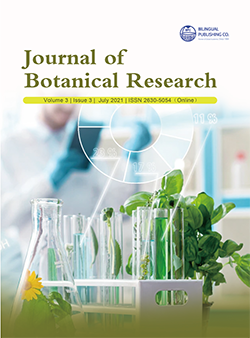-
221
-
195
-
159
-
149
-
148
Establishment of Fungal Decomposition Model Based on OLS and Logistic Model
DOI:
https://doi.org/10.30564/jbr.v3i3.3265Abstract
By using the OLS model, an equation for the rate of decomposing wood by a variety of fungi was established. We analyzed the effects of various fungi in the experimental data under different temperature and humidity. Based on the growth performance of different fungi at different temperatures and humidity, we use the method of systematic cluster to divide the fungi into 5 categories, and introduce competition levels as the viability of different species of fungi. We have established a logistic model that introduces competition levels to obtain a fungal habitat model. The fungal habitat model includes predictions about the relative advantages and disadvantages for each species and combinations of species likely to persist, and do so for different environments including arid, semi-arid, temperate, arboreal, and tropical rain forests.Keywords:
Fungus; OLS; Systematic cluster; Logistic modelReferences
[1] Lian Bin, Hou Weiguo. The role of fungi in terrestrial ecosystem carbon cycle[J].Quaternary research,2011,31(03):491-497.
[2] Nicky Lustenhouwer, Daniel S. Maynard, Mark A. Bradford, Daniel L. Lindner, Brad Oberle, Amy E. Zanne, and Thomas W. Crowther, “A trait-based understanding of wood decomposition by fungi,” Proceedings of the National Academy of Sciences of the United States, May 13, 2020.
[3] Bahram M, Polme S, Koljalg U, Zarre S, Tedersoo L. 2012. Regional and local patterns of ectomycorrhizal fungal diversity and community structure along an altitudinal gradient in the Hyrcanian forests of northern Iran. New Phytologist 193: 465-473.
[4] K. L. McGuire, K. K. Treseder, Microbial communities and their relevance for ecosys-tem models: Decomposition as a case study. Soil Biol. Biochem. 42, 529-535 (2010).
[5] S. D. Allison, M. L. Goulden, Consequences of drought tolerance traits for microbial decomposition in the DEMENT model. Soil Biol. Biochem. 107, 104- 113 (2017).
[6] D. S. Maynard et al., Consistent trade-offs in fungal trait expression across broad spatial scales. Nat. Microbiol. 4, 846-853 (2019).
[7] L. Boddy, Fungal community ecology and wood decomposition processes in angio-sperms: From standing tree to complete decay of coarse woody debris. Ecol. Bull. 49, 43-56 (2001).
[8] Wang Pengjie, Qi Zhihui, Zhang Haiyang, Tian Lin, Gao qionglong, Tang FangApplication of multivariate linear analysis in forecasting the growth of stored grain fungi [J]. Chinese Journal of cereals and oils,2020,35(01):107-112+120.
[9] Chunyan Yang1, Douglas A. Schaefer2,Higher fungal diversity is correlated with lower CO2 emissions from dead wood in a natural forest[J],nature.
[10] Lipson, D. A., Kuske, C. R., Gallegos-Graves, L. & Oechel, W. C. Elevated atmospheric CO2 stimulates soil fungal diversity through increased fine root production in a semiarid shrubland ecosystem. Glob. Change Biol. 20, 2555-2565. DOI: https://doi.org/10.1111/gcb.12609 (2014).
[11] Mouillot, D. , Stubbs, W. , Faure, M. , Dumay, O. , Tomasini, J. A. , & Wilson, J. B. , et al. (2005). Niche overlap.
[12] J. Hiscox, J. O’Leary, L. Boddy, Fungus wars: Basidiomycete battles in wood decay.Stud. Mycol. 89, 117-124 (2018).
[13] N. Magan, J. Lacey, Effect of water activity, temperature and substrate on interactions between field and storage fungi. Trans. Br. Mycol. Soc. 82, 83-93 (1984).
[14] R. J. Hijmans, S. E. Cameron, J. L. Parra, P. G. Jones, A. Jarvis, Very high resolution interpolated climate surfaces for global land areas. Int. J. Climatol. 25, 1965-1978(2005).
[15] Z. Shi, S. Crowell, Y. Luo, B. Moore, 3rd, Model structures amplify uncertainty in predicted soil carbon responses to climate change. Nat. Commun. 9, 2171 (2018).
[16] J. Heilmann-Clausen, A gradient analysis of communities of macrofungi and slime moulds on decaying beech logs. Mycol. Res. 105, 575-596 (2001).
[17] M. A. Rubenstein, T. W. Crowther, D. S. Maynard, J. S. Schilling, M. A. Bradford, De-coupling direct and indirect effects of temperature on decomposition. Soil Biol.Biochem. 112, 110-116 (2017).
[18] F. Ritchie, M. P. McQuilken, R. A. Bain, Effects of water potential on mycelial growth,sclerotial production, and germination of Rhizoctonia solani from potato. Mycol. Res.110, 725-733 (2006).
[19] D. S. Maynard, et al., Diversity begets diversity in competition for space. Nat. Ecol. Evol.1, 0156 (2017).
[20] B. Oberle, et al., Accurate forest projections require long-term wood decay experiments because plant trait effects change through time. Glob. Change Biol.26, 864-875 (2020).
Downloads
How to Cite
Issue
Article Type
License
Copyright © 2021 Author(s)

This is an open access article under the Creative Commons Attribution-NonCommercial 4.0 International (CC BY-NC 4.0) License.




 Mingkai Zhou
Mingkai Zhou





